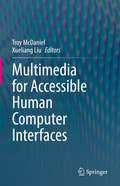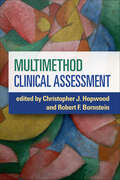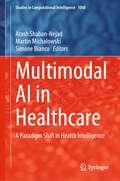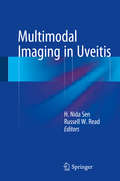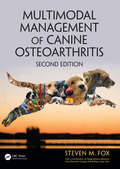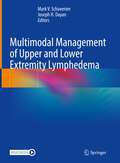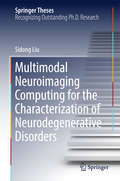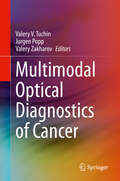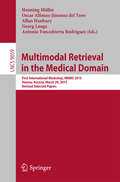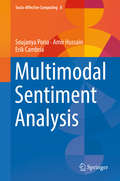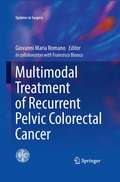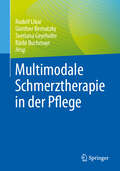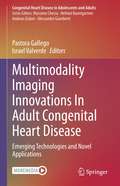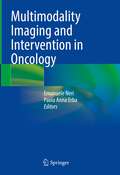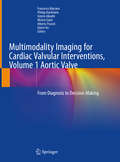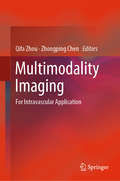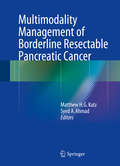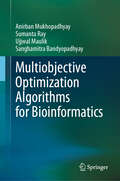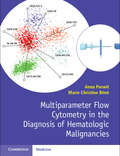- Table View
- List View
Multimedia for Accessible Human Computer Interfaces
by Xueliang Liu Troy McDanielThe book Multimedia for Accessible Human Computer Interfaces is to be the first resource to provide in-depth coverage on topical areas of multimedia computing (images, video, audio, speech, haptics, VR/AR, etc.) for accessible and inclusive human computer interfaces. Topics are grouped into thematic areas spanning the human senses: Vision, Hearing, Touch, as well as Multimodal applications. Each chapter is written by different multimedia researchers to provide complementary and multidisciplinary perspectives. Unlike other related books, which focus on guidelines for designing accessible interfaces, or are dated in their coverage of cutting edge multimedia technologies, Multimedia for Accessible Human Computer Interfaces takes an application-oriented approach to present a tour of how the field of multimedia is advancing access to human computer interfaces for individuals with disabilities.Under Theme 1 “Vision-based Technologies for Accessible Human Computer Interfaces”, multimedia technologies to enhance access to interfaces through vision will be presented including: “A Framework for Gaze-contingent Interfaces”, “Sign Language Recognition”, “Fusion-based Image Enhancement and its Applications in Mobile Devices”, and “Open-domain Textual Question Answering Systems”. Under Theme 2 “Auditory Technologies for Accessible Human Computer Interfaces”, multimedia technologies to enhance access to interfaces through hearing will be presented including: “Speech Recognition for Individuals with Voice Disorders” and “Socially Assistive Robots for Storytelling and Other Activities to Support Aging in Place”. Under Theme 3 “Haptic Technologies for Accessible Human Computer Interfaces”, multimedia technologies to enhance access to interfaces through haptics will be presented including: “Accessible Smart Coaching Technologies Inspired by Elderly Requisites” and “Haptic Mediators for Remote Interpersonal Communication”. Under Theme 4 “Multimodal Technologies for Accessible Human Computer Interfaces”, multimedia technologies to enhance access to interfaces through multiple modalities will be presented including: “Human-Machine Interfaces for Socially Connected Devices: From Smart Households to Smart Cities” and “Enhancing Situational Awareness and Kinesthetic Assistance for Clinicians via Augmented-Reality and Haptic Shared-Control Technologies”.
Multimethod Clinical Assessment
by Robert F. Bornstein Christopher J. HopwoodFrom leading authorities, this book presents evidence-based strategies for using multimethod assessment to enhance clinical practice. The volume is organized around key assessment targets in the areas of personality, psychopathology, and clinical management (for example, treatment planning and progress monitoring). Each chapter presents multiple methods that are particularly useful for assessing the issue at hand, provides a framework for using these methods together, and reviews the empirical data supporting their integration. Illustrative case examples clarify the approaches described and show how incorporating assessment into treatment can strengthen the therapeutic relationship.
Multimethod Clinical Assessment
by Robert F. Bornstein Christopher J. HopwoodFrom leading authorities, this book presents evidence-based strategies for using multimethod assessment to enhance clinical practice. The volume is organized around key assessment targets in the areas of personality, psychopathology, and clinical management (for example, treatment planning and progress monitoring). Each chapter presents multiple methods that are particularly useful for assessing the issue at hand, provides a framework for using these methods together, and reviews the empirical data supporting their integration. Illustrative case examples clarify the approaches described and show how incorporating assessment into treatment can strengthen the therapeutic relationship.
Multimodal AI in Healthcare: A Paradigm Shift in Health Intelligence (Studies in Computational Intelligence #1060)
by Simone Bianco Arash Shaban-Nejad Martin MichalowskiThis book aims to highlight the latest achievements in the use of AI and multimodal artificial intelligence in biomedicine and healthcare. Multimodal AI is a relatively new concept in AI, in which different types of data (e.g. text, image, video, audio, and numerical data) are collected, integrated, and processed through a series of intelligence processing algorithms to improve performance. The edited volume contains selected papers presented at the 2022 Health Intelligence workshop and the associated Data Hackathon/Challenge, co-located with the Thirty-Sixth Association for the Advancement of Artificial Intelligence (AAAI) conference, and presents an overview of the issues, challenges, and potentials in the field, along with new research results. This book provides information for researchers, students, industry professionals, clinicians, and public health agencies interested in the applications of AI and Multimodal AI in public health and medicine.
Multimodal Biomedical Imaging Techniques (Biological and Medical Physics, Biomedical Engineering)
by Sabu Thomas Parasuraman Padmanabhan Nandakumar Kalarikkal B. C. Bhadrapriya Bosely Anne Bose Murukeshan Vadakke MathamThis book highlights various aspects of multimodal imaging techniques. Innovations and progress in the field of advanced molecular imaging techniques such as Computed Tomography (CT), Magnetic Resonance Imaging (MRI), Positron Emission Tomography (PET), Single-Photon Emission Computed Tomography (SPECT), Fluorescence Imaging, Photoacoustic imaging(PAI), Fluorescence Molecular Tomography (FMT), Ultrasound (US), etc., are covered in this book. This book is an invaluable reference for students, professionals, and research scholars (primarily in the field of materials science, biomedical imaging, and nanoscience and nanotechnology) and also for those who want to nurture their scientific temper/skills in these areas.
Multimodal Imaging in Uveitis
by H. Nida Sen Russell W. ReadThis book is a comprehensive guide to the imaging techniques that have revolutionized the diagnosis and management of uveitis during the past decade, including optical coherence tomography (OCT), enhanced depth imaging, fundus autofluorescence, and wide-field angiography. In addition, the current role of the traditional (invasive) gold standard techniques, fluorescein angiography and indocyanine green angiography, is described. Among the newer imaging modalities, detailed attention is paid to the various OCT technologies such as spectral domain OCT, enhanced-depth imaging OCT, and en face swept-source OCT. Further individual chapters focus on imaging using adaptive optics, multiview OCT, and OCT angiography. Increasing use and better understanding of the different modalities described in this book are sure to improve our knowledge of the disease mechanisms involved in uveitis and likely outcomes.
Multimodal Interaction Technologies for Training Affective Social Skills
by Satoshi NakamuraThis book focuses on how interactive, multimodal technology such as virtual agents can be used in training and treatment (social skills training, cognitive behavioral therapy). People with socio-affective deficits have difficulties controlling their social behavior and also suffer from interpreting others’ social behavior. Behavioral training, such as social skills training, is used in clinical settings. Patients are trained by a coach to experience social interaction and reduce social stress. In addition to behavioral training, cognitive behavioral therapy is also useful for understanding better and training social-affective interaction. All these methods are effective but expensive and difficult to access. This book describes how multimodal interactive technology can be used in healthcare for measuring and training social-affective interactions. Sensing technology analyzes users’ behaviors and eye-gaze, and various machine learning methods can be used for prediction tasks. This bookfocuses on analyzing human behaviors and implementing training methods (e.g., by virtual agents, virtual reality, dialogue modeling, personalized feedback, and evaluations). Target populations include depression, schizophrenia, autism spectrum disorder, and a much larger group of social pathological phenomena.
Multimodal Management of Canine Osteoarthritis (Manson Ser.)
by Steven M. FoxMultimodal Management of Canine Osteoarthritis, Second Edition takes an evidence-based approach to the canine patient with osteoarthritis, pursuing the objective of the best available medicine by a variety of means: multiple drugs, agents, adjuncts and delivery methods. Appreciating that surgical intervention may initially be required, particularly for stabilizing a joint, the major focus in this work is the conservative management of osteoarthritis. A clear and visual approach is taken with the overlapping of two three-pointed triangles of management: medical and non-medical. The completely updated new edition offers a major new chapter on Regenerative Medicine in collaboration with Drs Sherman Canapp and Brittany Jean Carr. It is recommended for any small animal veterinary practitioner, as well as researchers and students of the RCVS CertAVP.
Multimodal Management of Upper and Lower Extremity Lymphedema
by Mark V. Schaverien Joseph H. DayanIn this concise, accessible, and comprehensive reference, world experts in the field of lymphedema detail all of the non-surgical and surgical approaches to the multidisciplinary management of patients with upper and lower extremity lymphedema. There is particular focus on the surgical treatments for lymphedema, where the reader is taken step-by-step through illustrated guides for each procedure by the leading experts in the field of lymphedema microsurgery; from patient selection, preoperative evaluation, surgical technique, and postoperative management. The book is strictly organized so that readers can quickly find content and provides readers with the necessary tools and framework to readily apply these innovative and state-of-the art techniques to their patients to optimize outcomes of surgical and non-surgical treatments for their lymphedema patients. Each chapter features a standardized content layout with full-color illustrations and clinical photographs to visually represent the content and includes key tips from experts in lymphedema, accompanied by key video contributions from the authors to demonstrate the surgical techniques. There is key emphasis on advances in our understand of the etiology of lymphedema, the most important surgical topics in lymphedema microsurgery, the current evidence available for the surgical treatment of lymphedema, and recent advances in lymphedema including new pharmacological treatments that target inflammation and fibrosis Edited by leaders in lymphedema microsurgery and contributed to by a multidisciplinary group of international experts to provide a full and comprehensive guide, Multimodal Management of Upper and Lower Extremity Lymphedema is aimed at a wide target audience that includes surgeons that perform lymphedema surgeries, other medical specialties that treat patients with cancer, lymphedema therapists, physical therapists, and occupational therapists, as well as nursing specialties and trainees.
Multimodal Neuroimaging Computing for the Characterization of Neurodegenerative Disorders
by Sidong LiuThis thesis covers various facets of brain image computing methods and illustrates the scientific understanding of neurodegenerative disorders based on four general aspects of multimodal neuroimaging computing: neuroimaging data pre-processing, brain feature modeling, pathological pattern analysis, and translational model development. It demonstrates how multimodal neuroimaging computing techniques can be integrated and applied to neurodegenerative disease research and management, highlighting relevant examples and case studies. Readers will also discover a number of interesting extension topics in longitudinal neuroimaging studies, subject-centered analysis, and the brain connectome. As such, the book will benefit all health informatics postgraduates, neuroscience researchers, neurology and psychiatry practitioners, and policymakers who are interested in medical image computing and computer-assisted interventions.
Multimodal Optical Diagnostics of Cancer
by Valery V. Tuchin Jürgen Popp Valery ZakharovThis book provides an in-depth description and discussion of different multi-modal diagnostic techniques for cancer detection and treatment using exact optical methods, their comparison, and combination. Coverage includes detailed descriptions of modern state of design for novel methods of optical non-invasive cancer diagnostics; multi-modal methods for earlier cancer diagnostic enhancing the probability of effective cancer treatment; modern clinical trials with novel methods of clinical cancer diagnostics; medical and technical aspects of clinical cancer diagnostics, and long-term monitoring. Biomedical engineers, cancer researchers, and scientists will find the book to be an invaluable resource.Introduces optical imaging strategies;Focuses on multimodal optical diagnostics as a fundamental approach;Discusses novel methods of optical non-invasive cancer diagnostics.
Multimodal Retrieval in the Medical Domain
by Henning Müller Oscar Alfonso Jimenez del Toro Allan Hanbury Georg Langs Antonio Foncubierta RodriguezThis book constitutes the proceedings of the First International Workshop on Multimodal Retrieval in the Medical Domain, MRMD 2015, held in Vienna, Austria, on March 29, 2015. The workshop was held in connection with ECIR 2015. The 14 full papers presented, including one invited paper, a workshop overview and five papers on the VISCERAL Retrieval Benchmark, were carefully reviewed and selected from 18 submissions. The papers focus on the following topics: importance of data other than text for information retrieval; semantic data analysis; scalability approaches towards big data sets.
Multimodal Sentiment Analysis (Socio-Affective Computing #8)
by Amir Hussain Erik Cambria Soujanya PoriaThis latest volume in the series, Socio-Affective Computing, presents a set of novel approaches to analyze opinionated videos and to extract sentiments and emotions. Textual sentiment analysis framework as discussed in this book contains a novel way of doing sentiment analysis by merging linguistics with machine learning. Fusing textual information with audio and visual cues is found to be extremely useful which improves text, audio and visual based unimodal sentiment analyzer. This volume covers the three main topics of: textual preprocessing and sentiment analysis methods; frameworks to process audio and visual data; and methods of textual, audio and visual features fusion. The inclusion of key visualization and case studies will enable readers to understand better these approaches. Aimed at the Natural Language Processing, Affective Computing and Artificial Intelligence audiences, this comprehensive volume will appeal to a wide readership and will help readers to understand key details on multimodal sentiment analysis.
Multimodal Treatment of Acute Psychiatric Illness: A Guide for Hospital Diversion
by Glendon Moriarty Justin SimpsonThe multimodal treatment of acute psychiatric illness involves a set of integrated, systematic interventions that stabilize individuals with severe mental illness and help them avoid unnecessary psychiatric hospitalization. This volume focuses on those suffering from schizophrenia, schizoaffective disorder, bipolar disorder, major depressive disorder, severe anxiety, and substance dependence, and provides individual practitioners and professional teams with the tools for responding to crisis and delivering acute care. The authors bolster the text with real-world case examples, helpful diagrams, and printable worksheets.
Multimodal Treatment of Recurrent Pelvic Colorectal Cancer
by Giovanni Maria RomanoThis book analyzes all aspects of modern multimodal treatment of locally recurrent rectal cancer in the pelvis in order to offer a panoramic overview of the different therapeutic options and enable the reader to balance their benefits and drawbacks. Indications for surgery and the surgical techniques themselves, including reconstruction techniques after major exenterative surgery, are clearly described and evaluated. The role of new imaging tools, such as MRI and PET-CT, in staging recurrences and guiding therapy is assessed and detailed consideration is given to the use of neoadjuvant and iterative radiotherapy and the indications for systemic chemotherapy. Morbidity, mortality, oncologic outcomes, and quality of life issues are carefully analyzed and options for pain control and palliation are examined. Finally, a national survey is presented on the state of the art in the surgical treatment of locally recurrent rectal cancer in Italy. While there has been a dramatic fall in the incidence of local pelvic recurrences, their treatment remains a major clinical challenge which requires a multidisciplinary approach and careful selection of the most appropriate strategy in each case. This book will aid practitioners in making the correct decisions in individual patients.
Multimodale Schmerztherapie in der Pflege
by Günther Bernatzky Rudolf Likar Svetlana Geyrhofer Bärbl BuchmayrDieses von Experten aus Pflege und Medizin geschriebene Buch bietet einen guten Überblick zu den häufigsten Methoden der Schmerztherapie in der Pflege. Neben den Grundlagen über Schmerzentstehung, -messung, und -therapie werden auch Leitlinien und Standards in der mechanismenbasierten Schmerztherapie sowie im pflegerischen Schmerzassessment und die rechtlichen Aspekte vorgestellt. Aromapflege, Ayurveda, Entspannungsverfahren, Musiktherapie, Massage, Physiotherapie, Hypnose oder Wickel werden ausführlich anhand von zahlreichen praktischen Beispielen beschrieben. Ziel der Anwendung ist stets die Reduktion der Nebenwirkungen von Therapien. Die vorgestellten Methoden eignen sich aber auch zur Vorbeugung und können bei stagnierenden Heilungsprozessen erfolgreich eingesetzt werden. Das Buch richtet sind an alle in der Pflege tätigen Personen sowie Betroffene und deren Angehörige.
Multimodality Imaging Innovations In Adult Congenital Heart Disease: Emerging Technologies and Novel Applications (Congenital Heart Disease in Adolescents and Adults)
by Pastora Gallego Israel ValverdeThis book focuses on congenital heart disease (CHD) and emerging imaging technologies. It covers all clinically relevant aspects of the fascinating new cardiac imaging technologies, including a comprehensive explanation of their basic principles, practical aspects of novel clinical applications, and detailed descriptions of specific uses in the broad spectrum of clinically important adult CHD. Innovations and emerging technologies for diagnosis and therapeutics, evaluation and treatment are continually evolving, and due to these advances in non-invasive diagnosis, there has been a significant improvement in the survival rates for CHD patient. Novel approaches to trans-catheter interventions and advances in echocardiography, MRI and CT imaging are being developed and incorporated into routine clinical practice, while emerging three-dimensional printing technologies are fundamentally affecting patient care, research, trainee education, and interactions between multidisciplinary teams, patients, and caregivers. In addition, translational technologies on the horizon promise to take this nascent field even further. Exploring the applicability of these emerging technologies in improving our understanding of complex congenital cardiac defect anatomy and physiology will provide new treatment options for this unique population. Written by experts in the field who are also involved in patient care, this book discusses the practical application of innovations in advanced multimodality imaging in the daily clinical routine and offers tips and tricks for beginners.
Multimodality Imaging and Intervention in Oncology
by Emanuele Neri Paola Anna ErbaThis book provides the reader with a focused review of multimodality imaging strategies (radiology and molecular imaging) in staging and re-staging the major types of cancer (i.e. thyroid, breast, colon-rectum, lung, prostate, pancreas, liver, head and neck, and hematological cancer), including rare neoplasms. In addition to presenting the possible diagnostic pathways for all oncologic diseases, the book identifies those interventions currently available in clinical practice (these being a branch of interventional radiology), while also examining and detailing molecular radiotherapy strategies. The work has an interdisciplinary appeal and, thanks to its highly informative and cutting-edge coverage, professionals as well as advanced students and residents in radiology, oncology and surgery will find it of particular interest.
Multimodality Imaging for Cardiac Valvular Interventions, Volume 1 Aortic Valve: From Diagnosis to Decision-Making
by Francesco Maisano Philipp Kaufmann Hatem Alkadhi Michel Zuber Alberto Pozzoli Edwin HoThis book provides a practically applicable guide to the use of multimodality imaging for managing aortic valve disorders. Details of how to successfully diagnose a range of aortic valve diseases is presented, with detailed information covered on the techniques and relevant criteria for pre-operative screening, surgical and transcatheter planning, intraprocedural imaging and related postoperative follow-up. Multimodality Imaging for Cardiac Valvular Interventions, Volume 1 Aortic Valve: From Diagnosis to Decision-Making enables the reader to develop a thorough understanding and confidence of how to make appropriate clinical decisions when confronted by a range of aortic valve diseases. It is therefore a key resource for practicing cardiac imagers, cardiologists and interventional cardiologists who encounter these patients in their day-to-day clinical practice and trainees in cardiology seeking insight on the appropriate management of these patients.
Multimodality Imaging for Transcatheter Aortic Valve Replacement
by James K. Min Daniel S. Berman Jonathon LeipsicThis book is ideal for cardiovascular imagers of all backgrounds as well as proceduralists (surgeons and interventional cardiologists) performing TAVR. This text is also of value for the physicians and nurses involved in the care of these patients, and for fellows-in-training. This practical text brings together guidance on using multi-modality imaging in one book and highlights its usage with a focus on patient care. Pre-procedural, Intra-procedural and Long-term follow up), this review offers expert opinion and evidence-based guidance on how to incorporate the various imaging modalities at each step in the care of a TAVR patient. Although much has been learned in the short span of time since TAVR was introduced into the field, our book will also offer recommendations for clinically-relevant research areas that will lead to best practice strategies for incorporating multi-modality imaging into TAVR patient care.
Multimodality Imaging: For Intravascular Application
by Zhongping Chen Qifa ZhouThis book provides a state-of-the-art overview of the combined use of imaging modalities to obtain important functional and morphological information on intravascular disease and enhance disease detection. It discusses the integration of intravascular ultrasound (IVUS, intravascular optical coherence tomography (OCT), intravascular photoacoustic imaging (IVPA) and acoustic radiation force optical coherence elastography (ARF-OCE), and introduces the integration of multimodality imaging systems, such as IR and florescence. It includes the latest research advances and numerous imaging photos to offer readers insights into current intravascular applications. It is a valuable resource for students, scientists and physicians wanting to gain a deeper understanding of multimodality imaging tools.
Multimodality Management of Borderline Resectable Pancreatic Cancer
by Matthew H.G. Katz Syed A. AhmadThis volume provides the most comprehensive coverage of clinical management of borderline resectable pancreatic cancer available. Authored by leaders in the field, the book focuses on current clinical management of this disease stage, the importance of multimodality treatment algorithms, and an interdisciplinary approach to care. Surgical chapters are well-illustrated to provide surgeons and surgical trainees with important technical pearls. Clinical trials and trial design are also discussed. Multimodality Management of Borderline Resectable Pancreatic Cancer is a valuable resource for gastroenterologists, medical oncologists, radiation oncologists, surgical oncologists, general surgeons, and trainees interested in the treatment of pancreatic cancer.
Multiobjective Optimization Algorithms for Bioinformatics
by Ujjwal Maulik Sanghamitra Bandyopadhyay Anirban Mukhopadhyay Sumanta RayThis book provides an updated and in-depth introduction to the application of multiobjective optimization techniques in bioinformatics. In particular, it presents multiobjective solutions to a range of complex real-world bioinformatics problems. The authors first provide a comprehensive yet concise and self-contained introduction to relevant preliminary methodical constructions such as genetic algorithms, multiobjective optimization, data mining and several challenges in the bioinformatics domain. This is followed by several systematic applications of these techniques to real-world bioinformatics problems in the areas of gene expression and network biology. The book also features detailed theoretical and mathematical notes to facilitate reader comprehension. The book offers a valuable asset for a broad range of readers – from undergraduate to postgraduate, and as a textbook or reference work. Researchers and professionals can use the book not only to enrich their knowledge of multiobjective optimization and bioinformatics, but also as a comprehensive reference guide to applying and devising novel methods in bioinformatics and related domains.
Multiorgan Procurement for Transplantation
by Paolo Aseni Antonino M. Grande Luciano CarlisThis well-illustrated handbook provides answers to important questions that may arise during the retrieval of multiple organs for transplantation and offers step-by-step descriptions of current surgical techniques for procurement of the various thoracic and abdominal organs, including heart, lung, liver, intestine, pancreas, and kidney. The coverage includes detailed instruction on liver splitting techniques and on living donor liver hepatectomies and laparoscopic and robot-assisted nephrectomy for transplantation. In addition, guidance is provided on preoperative evaluation for multiorgan donation, contraindications, management for organ retrieval in deceased donors, and organ preservation. The advice offered and the questions addressed will be of relevance not only to transplant surgeons, trainees, and fellows but also to all other professionals involved in organ transplantation, including nursing staff in intensive care units and emergency rooms.
Multiparameter Flow Cytometry in the Diagnosis of Haematologic Malignancies
by Anna Porwit Marie Christine BeneMaster implementation of the techniques of flow cytometry in diagnosing complex haematological diseases and malignancies in patients, worldwide. Featuring World Health Organization recommendations on pre-analytical steps, instrument settings and panel construction, this invaluable manual offers invaluable support for those researching, practising and analyzing the cause of hematological malignancies. Authored by leading experts, this book puts flow-cytometry into everyday context. With a focus on multicolour panels, the manual provides readers an experienced understanding of effective, implementation techniques. Practitioners of all levels are offered a background in a variety of diseases presented alongside the most current methodology. Wide-ranging and comprehensive; detailed images of healthy blood, bone marrow and lymph-nodes are illustrated throughout, allowing for effective diagnosis. Through engaging with differential diagnoses, the manual offers an understanding of similar symptoms and mimicking malignancies, avoiding inaccurate results. Featuring in-depth descriptions of chronic diseases; users can reach accurate diagnosis, first time. Focus on 8-10 multicolor panels, allowing readers to effectively understand how to plan and apply the panels in the most constructive way; Features up-to-date information and references, compiled by experts in the field; Illustrations are made using multiple analysis software options, highlighting the key features of various diseases, to best inform on diagnostic features.
